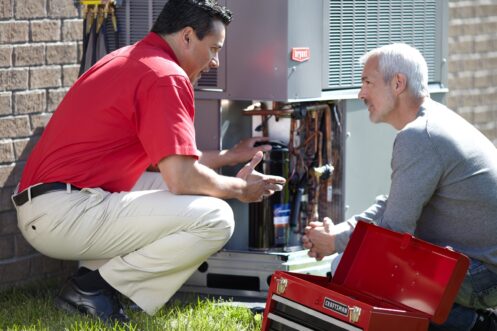
Central AC systems are fairly complicated and have numerous components that could experience an issue and prevent the system from cooling effectively. Various issues could cause the system to run longer than needed, shut off too soon, or even prevent your AC from running at all. Most AC issues will require hiring a technician to diagnose the specific source of the problem and perform an AC repair service, but there are also issues that you may be able to easily overcome on your own. With that in mind, here are some steps for troubleshooting your AC system. These steps may help you to diagnose the problem or at least rule out certain issues.
Make Sure the System Didn’t Trip the Circuit Breaker
If you ever find that your AC won’t turn on when the thermostat calls for cooling, you should first check your main electrical panel to make sure the circuit breaker that controls your HVAC system isn’t tripped. If the circuit breaker is tripped, switch your HVAC system off at the thermostat before resetting the circuit breaker. If not, the system could immediately overload the circuit and cause the breaker to trip again. If the breaker does trip again soon after your AC comes back on, you must leave the system off until it can be inspected, as this problem indicates that the system has some electrical issues.
Replace the Air Filter
If your AC stops putting out cool air or seems to run much longer than normal, the first thing to do is replace the air filter. A dirty air filter is the number one cause of many AC issues, as it greatly limits how much warm air the blower can draw into the system. Being diligent about replacing your air filter every month or two is also one of the easiest ways to avoid many common AC issues.
Check for Thermostat Issues
If your AC won’t turn on, checking your thermostat is a good idea. If the system doesn’t turn on at all, try switching the thermostat to heating mode to see if your furnace starts. If the furnace will run, but your AC won’t start, you can at least rule out the thermostat as the cause.
The next thing to do is turn the thermostat down by around 10 degrees. If the AC now starts, it indicates that the thermostat isn’t reading your home’s temperature correctly. In this case, the thermostat may be faulty and must be replaced. It is also possible that the internal components of the thermostat are dirty, as this can also interfere with its ability to measure temperature. The thermostat may need to be recalibrated or moved to a location that can better measure your home’s temperature.
Make Sure Drain Pan Isn’t Full and Evaporator Coil Isn’t Frozen
If your AC won’t start or you notice water leaking out of the air handler, you will want to open the access door on the air handler and check that the drain pan isn’t full. If water leaks from the air handler, you can be fairly certain that the condensate drain system is clogged or the drain pan is damaged. In this case, you must have a technician unclog the drain system or repair or replace the drain pan.
Many AC systems have a float switch in the drain pan that will shut the system off if the water rises too high to prevent it from overflowing. If the drain pan is full and your system won’t start, this is likely the reason why. In this case, you will need to have a technician unclog the drain system and then reset the float switch.
If your AC ever blows hot air, you will also want to check inside the air handler to see if the evaporator coil is frozen. A dirty air filter can cause a frozen evaporator coil, but it can also happen due to issues with the ductwork or blower. Other possible causes include dust covering the coil or low refrigerant. If the problem is related to anything other than a dirty air filter, you will need to have a technician fix the issue.
Listen for Unusual Noises Coming From the AC Condenser
Listening to the AC compressor outside your home can also help to diagnose the cause of some AC issues. For instance, a hissing noise typically indicates a refrigerant leak, which could be why the system is freezing up. Squealing noises usually mean the bearings on the unit’s fan motor are worn out and need to be replaced. If the bearings are worn out, the system will often only run for a short time, as the condenser will quickly start to overheat if the fan isn’t working properly. If the AC condenser doesn’t start and you hear it make a clicking noise when it attempts to turn on, it usually means that either the contactor relay or the start capacitor is faulty and needs to be replaced.
At MD Air Conditioning & Heating, our team can help you overcome any AC or heating issues you may have. We repair all brands and models of residential and commercial HVAC units. We also offer expert HVAC installation, maintenance, and indoor air quality services. Give us a call today if you have any questions or need any HVAC service in the San Antonio area.
Tags: AC Repair
